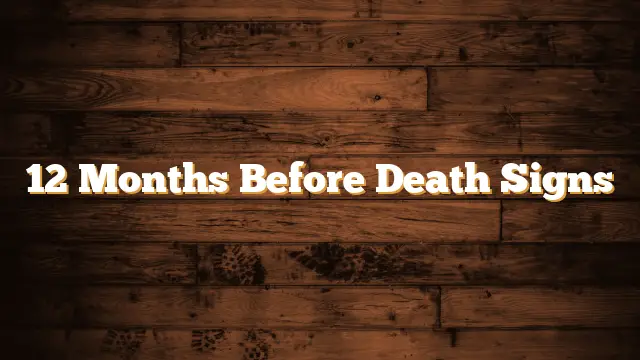Table of Contents
12 Months Before Death Signs
There are several signs that indicate a person is nearing the end of his or her life. Some of the signs include physical changes, hallucinations, changes in mood, and altered behavior. If you notice any of these signs, don’t ignore them! These are just a few signs that a loved one may be nearing the end of their life.
Changes in physical appearance
There are many signs of impending death, such as a sudden change in physical appearance. These signs usually begin weeks before death and become more apparent as the time draws closer. The final stage of dying, known as active dying, usually lasts a few days and comes with its own set of symptoms. Deaths that happen suddenly are not likely to present these signs, but those that come after a decline in health are more likely to show them.
Early signs of impending death can include a change in physical appearance and behavior. Many older people lose interest in things that used to interest them. They stop enjoying social interaction and no longer look forward to children or grandchildren visiting. They also become more silent and prefer to be left alone. They also stop exercising and reduce their interest in television, radio, and other activities that used to keep them busy.
Hallucinations
There are several warning signs of impending death, including hallucinations, which can occur in the dying person. These hallucinations are often accompanied by confusion, altered senses, and delusions. Hallucinations can include seeing people that aren’t there, or talking to people who have died. They can also include feelings or voices that seem frightening or comforting.
Patients with hallucinations should consult their physicians immediately. These hallucinations often begin before any other symptoms. Sometimes, they can be a sign of a chest or urinary infection. If you suspect that your loved one is suffering from a chest infection or other symptoms of an illness, you should call your GP.
Changes in mood
Changes in mood and personality can be one of the first signs of a terminal illness. The patient may be angry, bitter, or restless. However, these changes are not malicious, and the patient is not intentionally trying to harm anyone. They are simply experiencing the symptoms of the terminal illness.
Changes in behavior
Changes in behavior are a common warning sign for people who are nearing the end of life. These changes usually begin a few weeks before death. As time passes, the changes may become more noticeable, and new symptoms may also appear. The final stage of dying, called active dying, is usually shorter and comes with its own set of symptoms. Sudden deaths, on the other hand, are much less likely to include signs of death than those that have been gradual in nature.
Early signs of dying can appear in a variety of ways, including a decrease in motivation and a reduction in interest in life. People may also experience feelings of resignation and a sense of acceptance. According to Montoya-Juarez and colleagues, people use psychological defenses to cope with imminent death. They express their resignation by expressing negative emotions and thoughts. In addition, they may feel a sense of calm and acceptance in the months before death.
Changes in blood pressure
Several changes in blood pressure can signal the impending death of a loved one. These changes typically occur several weeks before the death. As the time approaches, the changes become more noticeable, and new symptoms may occur. The final phase of dying, known as active dying, lasts for a few days. This stage is characterized by its own unique set of symptoms. These changes are less likely to occur in sudden deaths, but are more common in deaths that occur after a period of decline.

